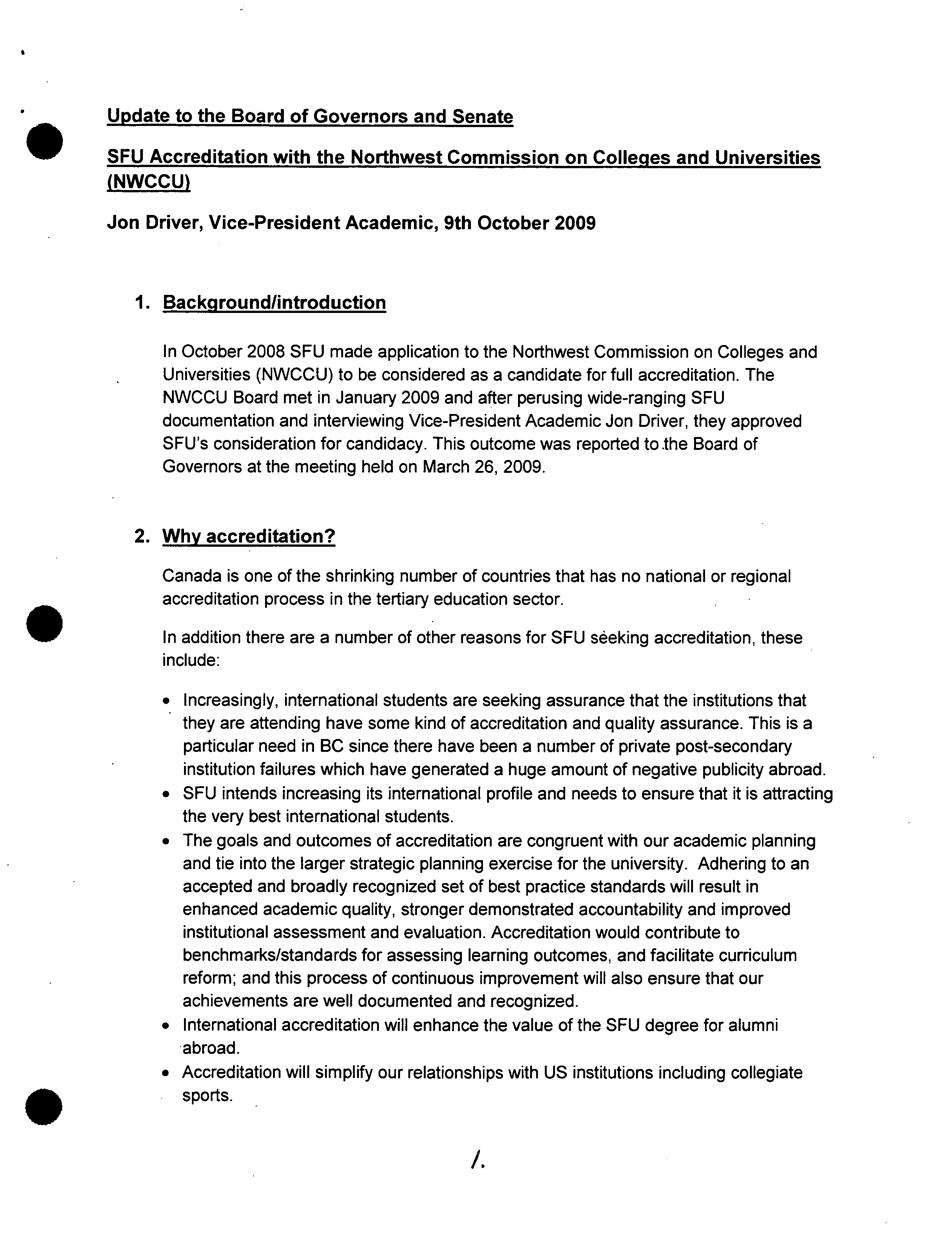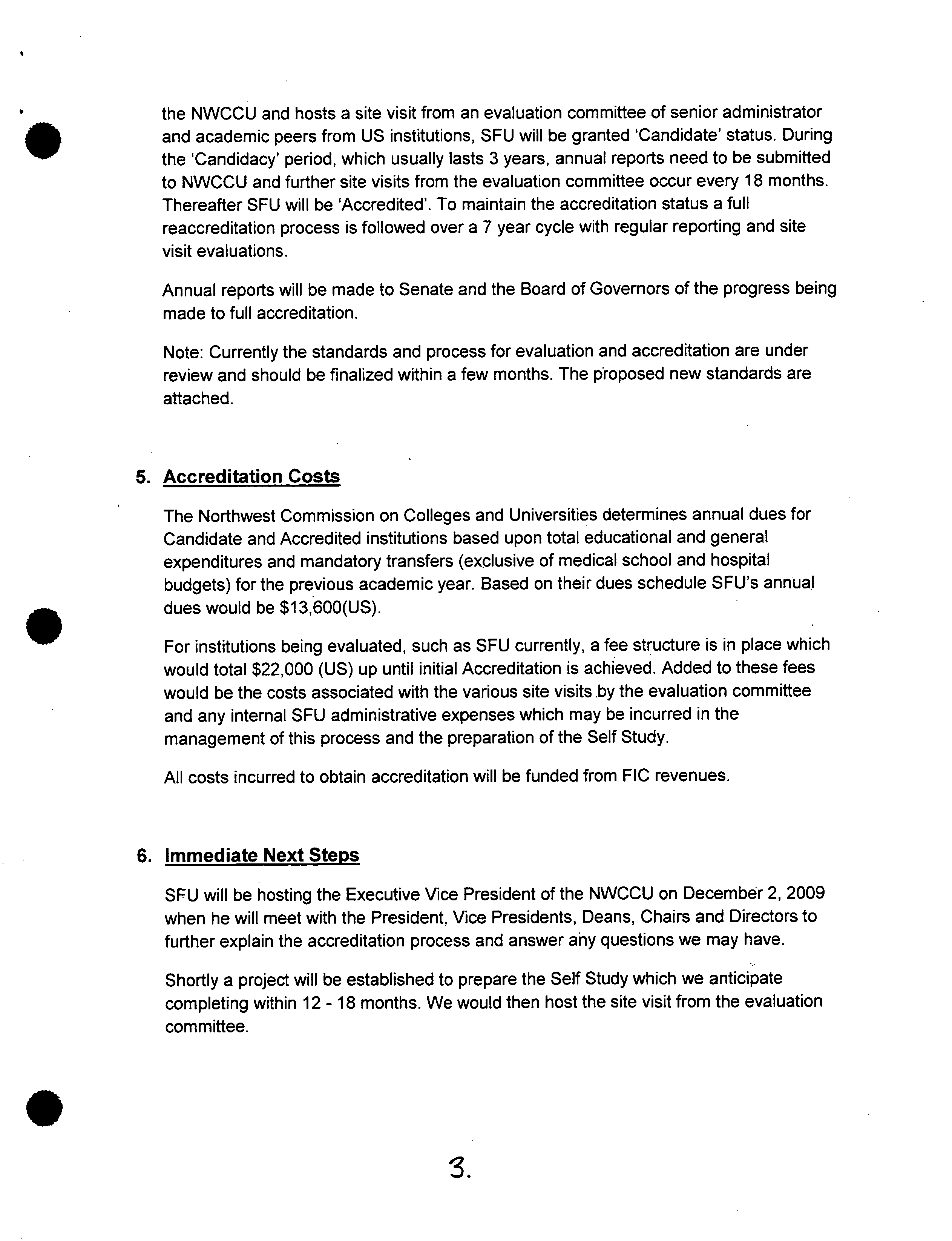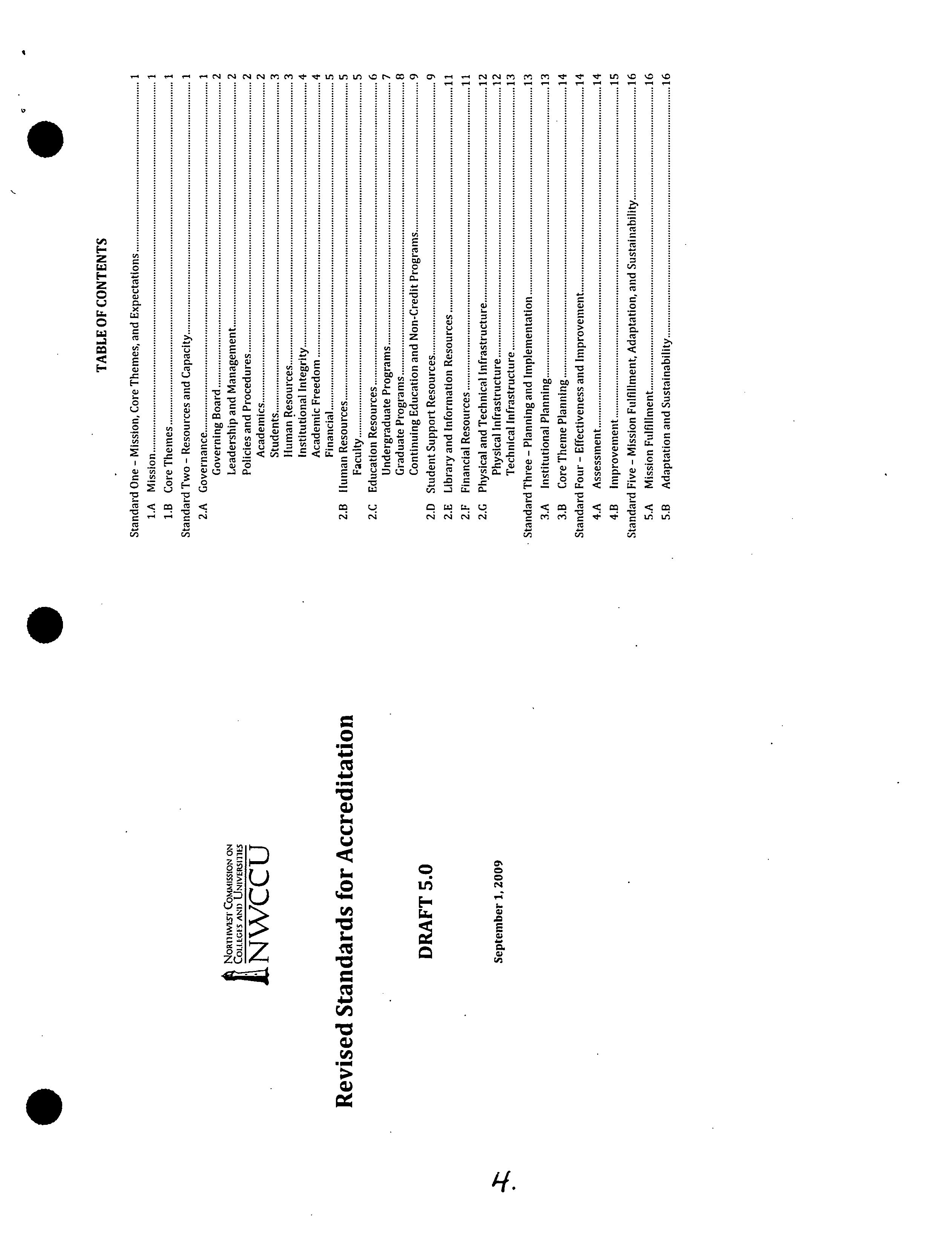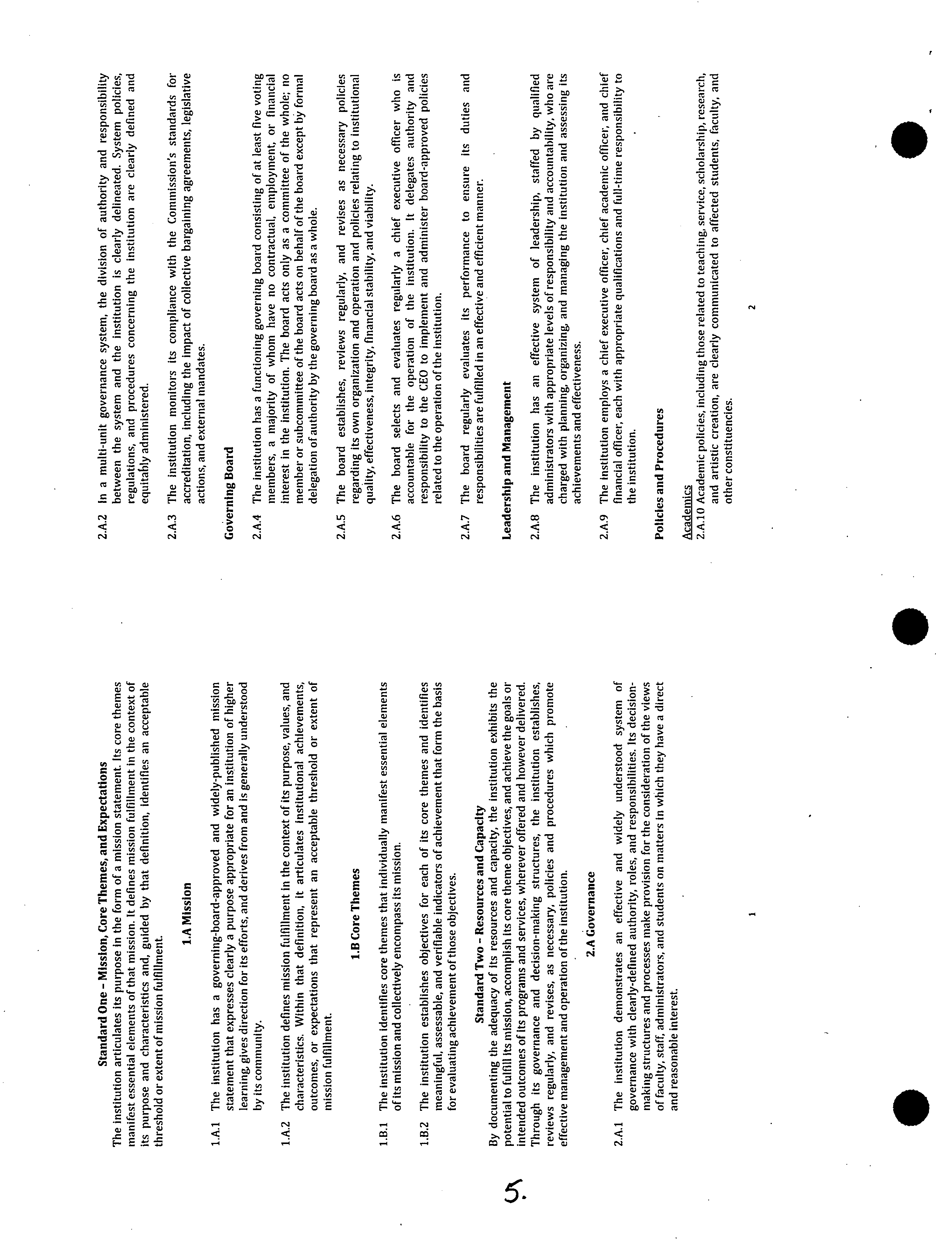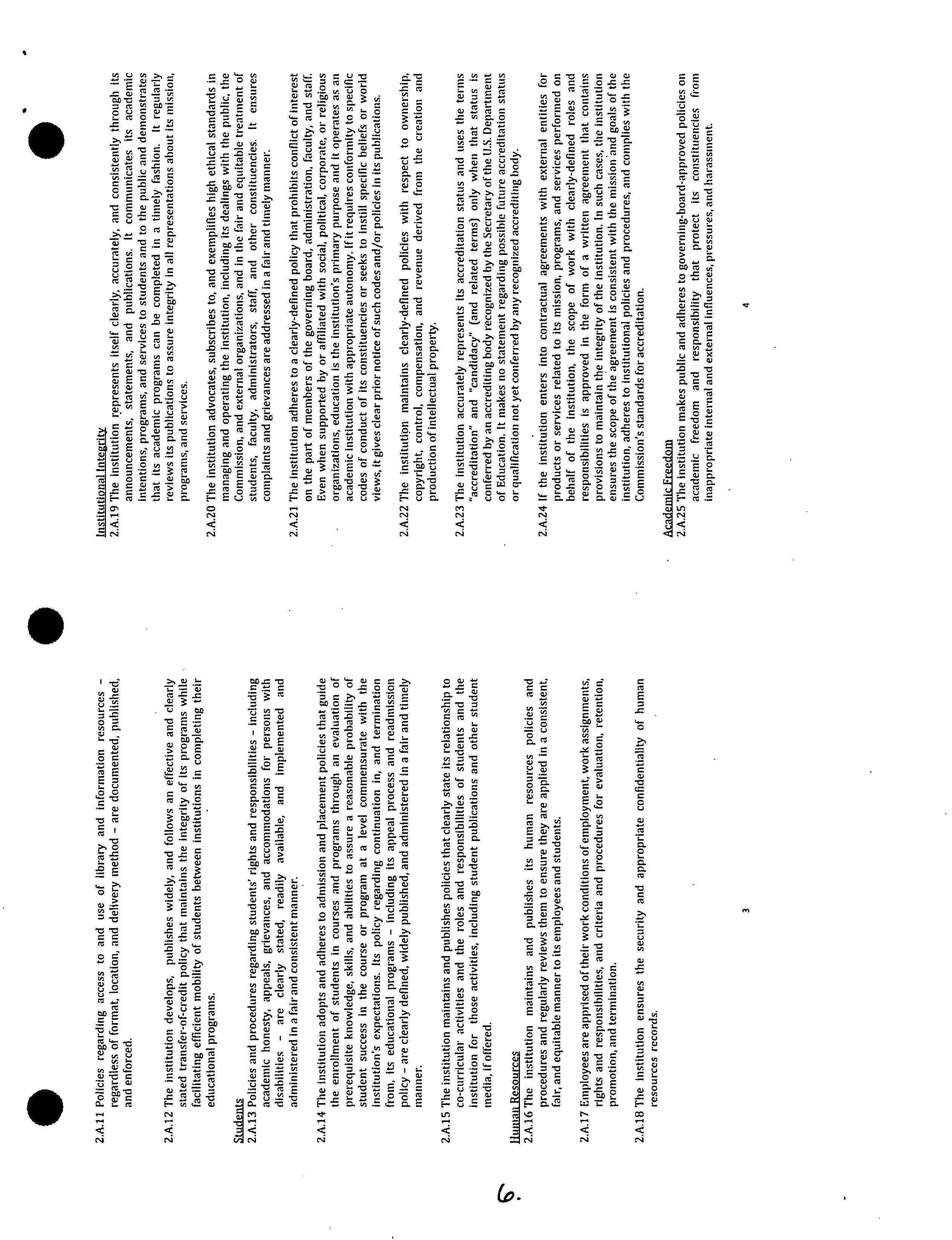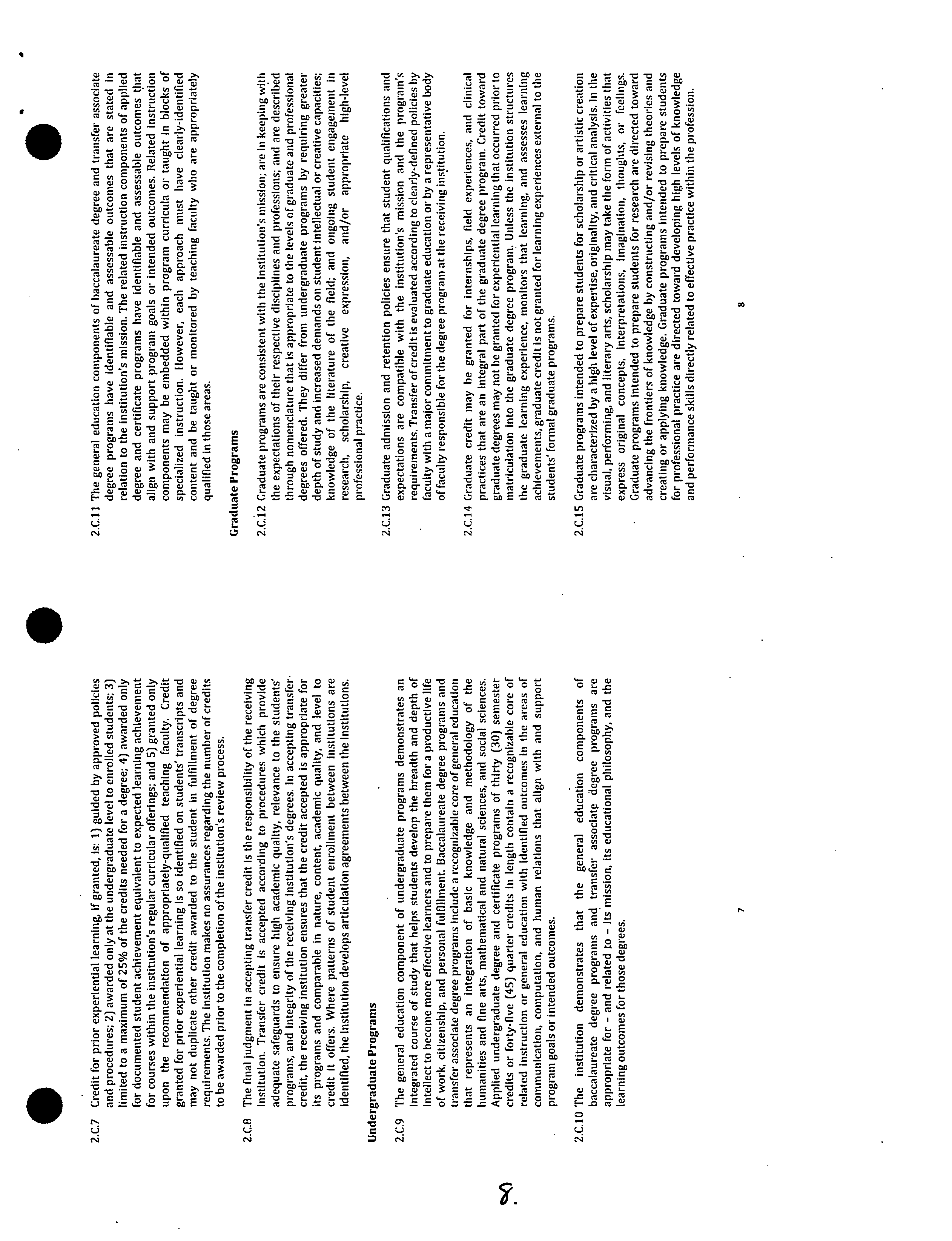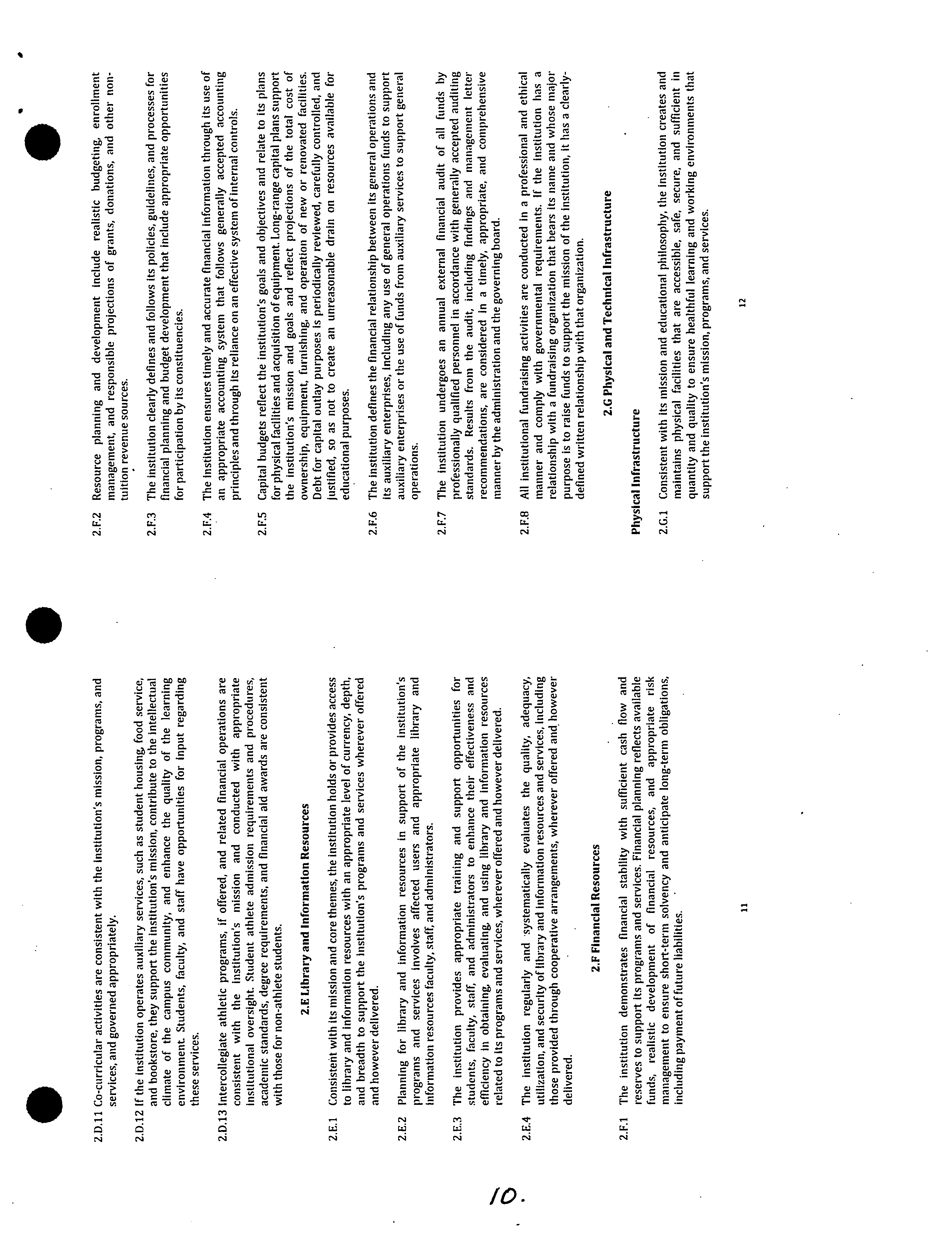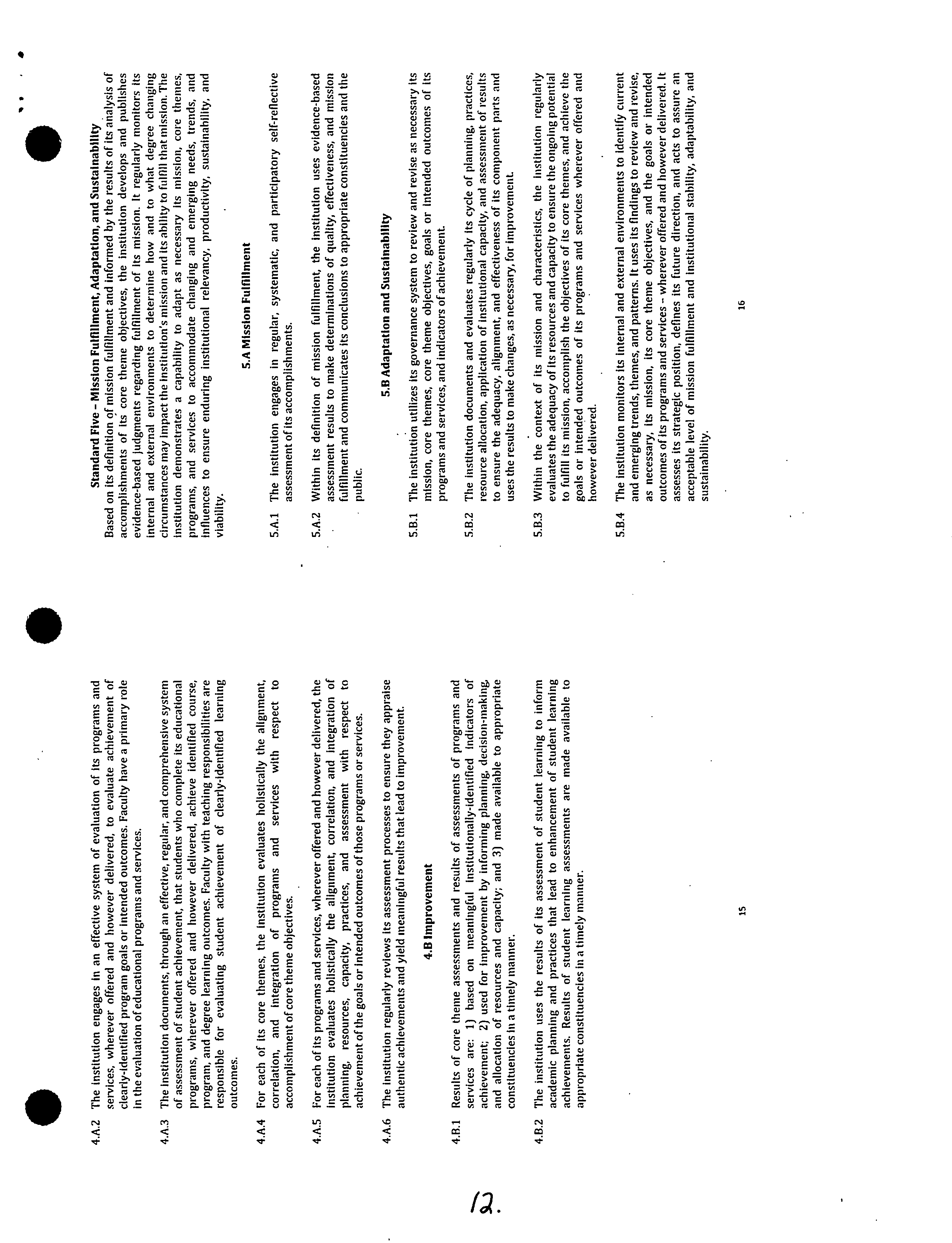11
?
El
OFFICE OF THE VICE-PRESIDENT, ACADEMIC AND PROVOST
?
S.09-120
8888 University Drive, Burnaby, BC ?
TEL: 778.782.3925
?
vpacad@sfu.ca
Canada V5A 1S6 ?
FAX: 778.782.5876
www.sfu.ca/vpacademic
MEMORANDUM
ATTENTION
Senate
FROM ?
Dr. Jonathan Driver, Vice-President, ?
Academic and Provost
RE:
?
NWCCU Accreditation Update
DATE
October 13, 2009
PAGES
1/1
I am providing for Senate's information an update on the progr
?
of our application for
accreditation with the Northwest Commission on Colleges and L
?
s, and plans for the next stage
of the process. I have also attached the revised accreditation stand
?
are currently being discussed
by NWCCU and the accredited institutions.
0
?
Attachments (2)
.
SIMON FRASER UNIVERSITY ?
THINKING OF THE WORLD
Up
date to the Board of Governors and Senate
SFU Accreditation with the Northwest Commission on Colle
g
es and Universities
(NWCCU)
Jon Driver, Vice-President Academic, 9th October 2009
1. Background/introduction
In October 2008 SFU made application to the Northwest Commission on Colleges and
Universities (NWCCU) to be considered as a candidate for full accreditation. The
NWCCU Board met in January 2009 and after perusing wide-ranging SFU
documentation and interviewing Vice-President Academic Jon Driver, they approved
SFU's consideration for candidacy. This outcome was reported to.the Board of
Governors at the meeting held on March 26, 2009.
2. Wh
y
accreditation?
Canada is one of the shrinking number of countries that has no national or regional
•
?
accreditation process in the tertiary education sector.
In addition there are a number of other reasons for SFU seeking accreditation, these
include:
• Increasingly, international students are seeking assurance that the institutions that
they are attending have some kind of accreditation and quality assurance. This is a
particular need in BC since there have been a number of private post-secondary
institution failures which have generated a huge amount of negative publicity abroad.
• SFU intends increasing its international profile and needs to ensure that it is attracting
the very best international students.
• The goals and outcomes of accreditation are congruent with our academic planning
and tie into the larger strategic planning exercise for the university. Adhering to an
accepted and broadly recognized set of best practice standards will result in
enhanced academic quality, stronger demonstrated accountability and improved
institutional assessment and evaluation. Accreditation would contribute to
benchmarks/standards for assessing learning outcomes, and facilitate curriculum
reform; and this process of continuous improvement will also ensure that our
achievements are well documented and recognized.
• International accreditation will enhance the value of the SFU degree for alumni
abroad.
• Accreditation will simplify our relationships with US institutions including collegiate
sports.
I.
3. NWCCU (http://www.nwccu.org )
Established in 1952 the Northwest Commission on Colleges and Universities (NWCCU)
is an independent, non-profit membership organization recognized by the U.S.
Department of Education and the Council for Higher Education Accreditation (CHEA) as
the regional authority on educational quality and institutional effectiveness of higher
education institutions. The NWCCU is one of six regional organizations, and services the
seven-state Northwest region of Alaska, Idaho, Montana, Nevada, Oregon, Utah, and
Washington. It fulfills its mission by establishing accreditation criteria and evaluation
procedures by which institutions are reviewed.
The Commission oversees regional accreditation for 163 institutions. The figure below
shows a few doctorial universities that are accredited by the NWCCU. The full list is
available on their web site.
Some NWCCU Accredited 'D' Universities & Date
of Accreditation
Boise State (1941)
Brigham Young (1923)
Eastern Washington (1919)
Idaho State (1918)
Pacific (1929)
Portland State (1955)
Seattle Pacific (1933)
Seattle (1935)
Montana (1932)
AlaskaFairbanks, (1934)
Idaho, (1918)
Nevada, (1938)
Oregon, (1918)
Washington State (1918)
Washington (1918)
Portland, (1931)
Utah, (1933)
Utah State (1924)
Its decision-making body consists of up to twenty-six Commissioners who represent the
public and the diversity of higher education institutions within the Northwest region.
4. The Accreditation Process
Institutional accreditation applies to the institution as a whole, not individual programmes
or units within their organization. Accredited institutions are distinguished by their
demonstrated ability to meet broadly accepted higher education standards of quality.
The value of accreditation is not limited to quality assurance alone; it also fosters public
confidence in the institution's ability to fulfill its stated mission and goals.
The full accreditation process will take between 5 and 7 years to complete. SFU is
currently classified as an 'Applicant'. Once SFU conducts a very detailed Self Study
detailing how its policies, procedures and practice relate to the standards prescribed by
2.
the NWCCU and hosts a site visit from an evaluation committee of senior administrator
and academic peers from US institutions, SFU will be granted 'Candidate' status. During
the 'Candidacy' period, which usually lasts 3 years, annual reports need to be submitted
to NWCCU and further site visits from the evaluation committee occur every 18 months.
Thereafter SFU will be 'Accredited'. To maintain the accreditation status a full
reaccreditation process is followed over a 7 year cycle with regular reporting and site
visit evaluations.
Annual reports will be made to Senate and the Board of Governors of the progress being
made to full accreditation.
Note: Currently the standards and process for evaluation and accreditation are under
review and should be finalized within a few months. The proposed new standards are
attached.
5.
Accreditation Costs
The Northwest Commission on Colleges and Universities determines annual dues for
Candidate and Accredited institutions based upon total educational and general
expenditures and mandatory transfers (exclusive of medical school and hospital
budgets) for the previous academic year. Based on their dues schedule SFU's annual
. ?
dues would be $13,600(US).
For institutions being evaluated, such as SFU currently, a fee structure is in place which
would total $22,000 (US) up until initial Accreditation is achieved. Added to these fees
would be the costs associated with the various site visits by the evaluation committee
and any internal SFU administrative expenses which may be incurred in the
management of this process and the preparation of the Self Study.
All costs incurred to obtain accreditation will be funded from FIC revenues.
6.
Immediate Next Steps
SFU will be hosting the Executive Vice President of the NWCCU on December 2, 2009
when he will meet with the President, Vice Presidents, Deans, Chairs and Directors to
further explain the accreditation process and answer any questions we may have.
Shortly a project will be established to prepare the Self Study which we anticipate
completing within 12 - 18 months. We would then host the site visit from the evaluation
committee.
.
3.
— - - — —
ri c' r4 r
.
M M
?
ui u
?
s 00
C' C' - -
r' ?
'C
'C 'C
U
a
- -
C
2
0
D . C
cu
C .0
U,
E
U
U,
-Co0
cC - C.
z
LQ
0
z
0
C
L)
o
- ?
U
C
o
:
:
C
c
I 0
E—-
C
C ?
:..
C ?
2
C
C.
I ?
I ?
I
0
U
z
?
::. ?
10
11
1 . 10
cUCU
I ?
c ?
0
?
I
U,2EO_
I :
?
U0U,U ?
U, U,
?
U,
E
:000
?
-0C. to °C 0 EC— C
?
0...
U, ?
C ?
C —
U,
U 0. 0
C 'U ?
>U
. ?
00
.
U. (C
?
U,
cq
cli ?
14 ?
C.
U,
U
U,
cz
C 0
CC
U,
.2
C.
0
. ?
.
S
U
U
Hu
?
Ln
?
N
-4
.
LD
0.
PC
S
'•I.
-
>
( ?
-C
a
C ?
C
-E'
C
CL
=-
.0
U
.E
=.•C
C
—
—
- ?
-
w
?
.
cu
-
.
= c ?
C
2
> -
2E
cc
w
=--=
EE
=
..E
.43
CC,
m
m-
lz
-CC
aj
U
CU
—c.UC
C
C—
CCC
—
>
._
c.
-
C.--
E
•
a°-
—
_C
2E
C.2
=
2
CC
Eo
-CC
;-
'o
2o
2
2 .9
-•
-=
2= C '
cc
2
2
cu
2
-
-
ol
I'D
r4
cli
cu
II
Ii
It
.
H
U
r o-
CC
cu
XL
LU
UC
—C
sw-
C
CL
EE
m
ca
S
..CO
ajC
C9
C
-w
>L
1QC
-CE
..—
C_
C.cO
2
CC
C.=
E
cz
CL 0
L
E
ZE
C.
C ?
U
UU
C C
L
u ?
-
>L
U
P.
CA
.E
.tC
L
U
LUC
-
2'
E
U
Mo
-
-'
U
b C"
20
U
U L
V cc
I!i
H
Eli
su
-5
.2
2=
2
—
C-9
— 2 C
L
.EE5
U
.C•—
UCC
.—
CE
=._c
>
=
CC
0-0
L
E —
CC
C
—E
C C-
C
C
-
-
.2
2 > C
C;
—
2 .
-
U C U
.
C
_9
cz
C
?
QCC
C
C ?
CCC
cu
o
eq
i
E
C
C C;
U C
C—
C
U
E
C;
_E
pf
-
Lu
fl
•
I!1
1I4
:
H
E-=s
-F-'
55
0
co
-'E--
• p
?
— .—
-= ?
-
c
'---
oc
c•._
_
-
-;
,
—
Ii_HI
.
20E'.-
—-
•
E
10
-
-;u-
h-1
EU
'H
rz
mfl
-E
—
-.
--
.9
,,
•9
o
OD
-
M
•rflt
— EL,u
—OLOcU>
Uil
?
E—u.
- ?
UCO
CL
-Q
a,
CD
-
N
N
N
N
C14
r-4
?
cla
c-_I
NI
NI
•
) C
?
-
I ?
>
0 ?
—
- ? - ?
0
0_.=c._
.9--
I--
?
-
to
I
0-
0
•-
_0_
I)
e
—U
:
?
I
E
E•-o
-E
cc
0
->
?
-
r-
M ?
_9
-
?
-
E
- ?
- -a
m
.
.0 E
cc
-o ?
00.
?
0.
CU
2.c
-B
-
I_
CL
00
Or—
= ?
-c
- ?
—
=-c•
c0__
cu
- ?
-
I,
C0U ?
•=
0 ?
>
?
c_
0
-
-
0c
=c
-
lul T;
— ?
—o
•o
.I5
aE
•
c
—o
2
=
-c-
-d
0.
-
—
"
E---
E-
•-c—
--ccE.c
oEc
U0c
-
?
=—
EE
cE
2°-
0.cCc
-0,.EEL
E—U.E
—
-IC
NI ?
NI
c4
NI
NI
-IC
c-_I
-IC ?
-IC ?
-IC
c-_I ?
NI
?
NI
(D.
C
-
1.2-1>
>. a.,
• ?
Ca
a,
• c
Ca ?
aa.-
•
C
.2
— ?
.
Ca
5 ?
E '
22
m
°
E
•
°=
EE
.E
Ca
.t
-Ca...
U
Ca
C.a,
CCOJCa
a,aJ
a0
Ca
a..-0_
;2
Ea.
••=
CC)
a,a)-o
CV
a,-
5CaC
°
?
-
cac
E4
a
CC
cu
•
o
_U
C
Ca .
Ca0
;ECa.=o
CCU
CaUC
CC2
°--
00
a,
UCa,
U._
a,C2C
?
•
-
w
•'p
cz
2>
C
CL It
C.p
•E
E0.
.2
Ca.CC
.o
2.J.
-e°
a,Ca
.
.
,.
U
CC)
•0U
Ca,(C
'CaC
C)C
.
tb
2
->
N
Ca
2i
U3Ca
E
2
CC)_CC
Ca>
a.a.-
>
CaC
a,.
C.0
Ca,C)
.0
Ca'-Ca
>2ga,o
C
C_a, ?
C
.2.2
C.
aaa
Ca
mu
Or-
.
2
E2
.ua.•
a,C
UC.
Ca,
CCa
'--2
C0a)
CUC
to
rL
•C0
C
M.
CL
Eao
rl
ij
C',
C'I
U
C')
L
C')
L
ci
C',
C')
ci
C')
S
L
> 0 ,, ?
a.) ._
a,
?
a
C
C-
?
Ca
a, .
a
C
,.. .- a, C
> CaO.C
)C
Ca
CaCa,C a
C
C-Ca
C
Ca
?
.
>CC
cu
C " C
C
a
CaC. E
Ca
Ca
a, ?
Ca
CC
0Ca
.2 C
?
Ca ?
)) .0
U'a,
-
U
Ca
E
.CUUCCCJ
CC
Ca0
to
000Ca
0
?
to
aj
a,
?
Ca
?
•Ca
a,C_a)CCO
Ca
a,0
Ca
.
Ca
CaCO3
'-C C
- ?
a)
00
'-.2
C
.00-.0
UCa,
>
2.2=
a
0
-;-C,
CoC'CC.
= 0
to
...Ca
CECa
E
?
72
UC0CaCa
C
E-
.->Ca
0a,C_a,
?
.0
C
a,CaCaa)a,C
C)C Caa, C ?
C
-2>
Ca
to
?
C_
a,5o._
C2 ?
.E
C>
Ca C
EEa,Ca
E
•.-
r4.
E0
co
E22
<
a-I
.21<
'E-
C.çjC.O
C. ?
C
Ca
-
a,a,
a, CaC.
Ca.CC
--
C ?
•0
Ca 0 0 C a
E
e
'
>Ca.a,
2C
C.Ca
a, ?
-
j1
Ea
cu ?
w
2
a,a,
E
7E
0C.
C-
Ca2
Ca
?
'Ca,
cc
Ca
Ca
>
2t
C ?
.
Caa,
C-
?
_ 0
C
bo
C
C—
= C
CaZCa
C
.0
C
Ca C C
E
.5 0
Ca.
?
C 0
Ca.
•C
CC
co
0C
ca
N ?
Cao
Ca
?
C
Caa,Ca
Caa,0
Ca ?
U
.Eo
CaC-a,
?
.o
-
Ca
Ea,-o.E
C'C
C
> ?
C ?
- CC
C-
a,
U
a, ?
C,_
CC
C.CC
c
Ca
Ca
C
C. ?
Ca
C._ U
E
2o
CCa
•5
a
•
lw
Irs
2
S
w
06
••E2
-
-
00. ?
a
--' ?
E=u
to
- ?
JZ—
uw_0=
.
=_
.=
_c=•=
Q
=0=ea
4)
to
'-E2
c=._
00-0
I!fluIH
il!I' hIU I1Ii
J!ID
cz 22
=_
2>
!j-=
-H-
-a=
0
0
= ?
oE-=
o
ob
It
cm
_•r;
CL
C
_.C_0_
tt
—
E-0o
oo_.
-._e
.=u_.
C'4
Ln
Li
Lj
Li ?
L
L
—'>
0
—o-,°3
-.
aco
O
)
..
CL
cc ?
>
h
I- V
00
?
in ?
Ii
—
ilil i
fl
hI
-hiI
—
U ?
0
mil-
-
--
acE
>,co_o
_,-
cu
;_;-
to
-=
E
=
'C__=>c
00_== ?
=
EE
E ?
E
tO
c
w ?
.0
D
!Hih
IHU
IU1
ii:
-13 ?
0 ?
i!iliU
Yjoc0
iF
-E
ou-.=
-
—
C.
?
0 ?
0.-
't 0
=
?
2
F- 5
?
ro
u
F-
?
S
o ?
.
?
U .. u
0.
F-
wC
Li
L
0 ?
L
F.
•
u.
2
w
CE
cz
SP
— ? - ?
-
-- -
o -
-
—>
-
co
2
05
m
to
Z
-
?
.
o
C-0-
0• ?
••
0._-
•5
0
,-
w
0>
Qj
.-
M.
?
a2
il
fl
0
-0
0
t5 w
.
.
—
U PR-i
0
o,,
0.
.co
—2oo
oo
oo
E
00
.-oc-'
-o
0
' a
00 ?
o.
o
>
?
to
co
E.
o.
Eoo
- ?
•—•-c,j
0
ø
C
C.
o
.
h-
-
?
co
o
?
o
22
to
oE0
u
00—
o'co
_uuoZ2-O<
Q-
0
?
ZCO
.0
0O
-o--oo
..-o°
E-..2
.Ecco
;0.00
0
CD
-'
N
N
N N
N ?
N
> -o
?
o
oo -
-o
" ?
o ?
-
-o o
CIO
2
0.0
?
E
.
C_
—
uCO2
0
0 ?
to
.-
>c
o0
c
_O)_0
0
°-
>
o.
EEO
EE'o.
'ajo0
'D._
_ ?
-
->
.
2
w
ooc
0
> 2
72
- ?
0
0
u
Ts
2u
oo
o;o.
E
.2
o
oco
-0
—C. ?
C
E
-
cc
2
to
-oo°
—o
o
=
?
EE
°->
hwo
U
aJ
,,
o--
O)
C
E.2
Z
•E
r,
2
°°
0 0 2
?
.o
?
C
•
co-o_
'
•- c ?
o -o
0 ?
0 ?
0
0. o.
00.
o
CL
;2°
Im
I
-
0.C°2°.
_o
H
-U
-U ilI
!-H ?
!;
U
U ?
U
N
U
N
N
N
?
r4
N
N N ?
N
'
2
-E
5
uc
o.
to ?
u-
!n
•QC)>
-C
.
- c
-
2 0 ?
C5-C)>UN
C)N-
.
C)
-
.
i-
5
-
C)
N
c
NC)C)O
-
-C)
•9c
•
.O
9
C)
-Q
C)
?
-
N
c
?
N
.=
=
-
h
ii
t
6-
72
W
CC
-;
-
-
a
w
?C)C
ft-F
u
-
C) ?
oo
--
cuC)
o
.2
.o
°
N
0C
R to
i!-
w CL
W
ca
C)
N5
NC
.EN
N
-
•
0
E
N ?
-
.
?
N
UO
N
C)
?
N,_
o-
C)
.:i
.
-
0. -
0.
>
0 -
.9N
0
?
r:
0 ?
.
5C?
.C).0
-
0
0 C)
UC)
to
-
CL
N.9E
N
N 0
L
0 ?
0.0..._.
.
00
.w]
C)CC
C) ?
0.
0
-toCC
s E
C) ?
C) ?
N
CJ ?
C)
N
oo
N
CO
.
?
C) .
CC
o-o
u
9CC
CC•
CC•C)
MCCO
E
....0C)C)
0.0
C
0.9CC
CC0.0 ?
0
C)CC0.C?
.0
..0
C)•
0>
C.
C)0
NC...0
o
C)0
>C)C)
0.
0C?
0C)..9
.=
U ?
CC ?
N0N
00.
E
C..>
t
C)00
C)0
.
-
-
00C)0
0.
CCU
0C)O.0
CC
NuC)
W
N0.CC
IR
0 C7
0C)
0
rL
oCC
.9
.E
C?
0 ?
CC
C?
0.
.C)
.0
.NC)CC
.0
-0
?
.9
?
0
?
.-
cz
C)
._0
N0
(C
?
0. ?
C?C)
N ?
QCC
CCN>
00C?
CC
•-
UCC
? -
N
C)
-
...-.C? ?
0 ?
C)
0N
C)
C)•0 C)
E
-
-
N
N>
0Z ?
.9 ?
.0
=CCCC
>90
.C) ?
- ?
C)C?
C.U5
CCN..
.0
0.
?
b
NOC)
>, r,
?
-
C)
0Q0
;o CC
NC0
E
E-0
•>'-
CC
C)0.
0.
CC
CCOU
0.
eNC)N ?
CC
.. ?
00
-
NU
C) ?
0
_00
>0
N
CC
0.
H
C) ? - ? =
CC C)
. ?
CC
Ffl
CC > .0
0
o
?
-
H
>
N
?
Q >
CC.0C)CC0
.0
0
N
0-u ?
C)
0
. ?
-5.9
.9
•S
CC
CC..00C?
C)00c(N ?
•0>C)
- ?
o
CCN
-
0
?
?
.>..o
- -..>
90
?
-
0
NCC
0.
C).00CC..C)
-C)
?
.0.0.0
C)C)
C)C?
C3
..9
W
-
.-
N
.-
- ?
.-
N
ri
N
C')
N
?
C')
C')
C
C
N
CC
N
10.
C
a)
CC
Ca
0.
C
C
C
Ca
Ca
C
0
C
C
CC,
52
a)aC
.5
.2'-
C._.
ci
C-,
-.
CC-
CCaC
a)U
C-
a) ?
.0 ?
bC
an
Ca-
C
E
CC
a)
Ca
C.
Ca
-C
.2
a, .0
a)
C)
Ca)C
a'C
C
a) a)
.
.2
.
-
U
C.
C ?
'
'9
.E
ae2
a,
.
.
CC
p
•U
5C.
.8
. 2 ,
.8CE
a
C8
.
.C•
to
It
C
C
a)a,
a,
UCC ?
a,
o
.
E
C
'
?
.
w0
.5
.
.20
.5
.
2
U
?
c
cCC
.
a,a
0
:r
U
U
=. Eo•
-
!D
Ihi fl!ilU'
a)
a)
E
e-
aCa)
It
.0
to
.Ca)_
.
•-a
.
'a
' -
.
>
_1
>
U
--E
0
"
5.
-
?
-
L
-
?
C
a) ?
a)
C
-C2
a)-0
C ?
ca
2 ?
2
= 0.
.02
.0.
5ca
aC
C
UC
ga.; ?
C
0. .0
5
E .
0.
C
C > C
C
--
a, ?
.0
C
Ca
. ?
C ?
..
a, a) a, a)
?
D
> C , C
a)
= .-
?
tw
oC
Eo-too
.
?
-
a,
.-
U C
U
C
.9 u
a,
o
0
.'C
a,
Ca)
a,
E. ?
-
0.
0
?
a,
C0.0
0Ca
?
a,
t52
.2.E
=
_Ca
3.?'
a).5
5a)
-0a,
a)•
E>
?
Ca, u'. ?
mu
a,
a)
a, ?
C
a,
•5.2,
.
.5,a,
- 5
a) - ?
a,
.
.
a)0
a)0.
a)
to
um
.9CC..0
2°5
C.
LcaC.0
C...2a)C
- Ca
N
C
iJ
N
C
a)
<
<
<
.
CR
.
.0
- C 0 C U
-c a)
Ca>
>a)
a)
a)0
C
t
C ?
.
UCa)
a,
a) ?
-
0
C
C
C C
a,a)a)
a
ac
CCa0
?
."-
F0
E
a,00.
.0CC
a,CaC
.0
.
Th
2
.
.
.
.2
.
Ca,>a)C
a)
0._
to
a,
50
a)Ca, ?
C
22
•20.
t
8
-.0
a,t
.CCa)
U
a,
.E
U
C
.Ua)0.•CCa
2
cc
a)Ca,4. 0 ?
C0
.
s
Ca 0
0. C
>,
?
a,
0.
a,
_aa-
a, ?
C
000
C
SE
E00
?
0 C
Ø)
aa
.2
>
a,
.5C
EU ?
C..2
0
a,
C3
-Eo
a) ?
-
>0._C
0-0
o0
•
'C
a) C
C
L
C..0
ca°0 ?
00C.
CC.a,C.. ?
Ca,
a,
.
aa0
Ca.Ca)
---
CL
to
C
-C_.0CaCa,0
>C.
U.2
E
to
Ca,
5oa.
a,
w
a)Caa,
C0
C..0
a,>,a
a)_
0.00.
C
-C.2
Ca,_a,
OCa,>
a,a,
a,.C,,
C
a)
?
-
0a,0Ca,C
a,
CL
r
9C
C.a,-
U0.0
CCa)
a)a)
C
C0.
a)a)
a,
C
Ca0U_C..20
?
00.2
Ca
.0
a)-ca
?
.2C..0
;->
Eu
Ca00a, ?
0a)
:
-9
a).
a,
F
..00
CC
a,C
a,
CaU
a)
...Eaa
E
.22
.E'a
a)C.0
_
o
Ca
-
5
a)
'-
a,-a,
50
_
ca
"
CEa)
?
''
a,U
cc
r
_0.0
.Ca
0C.
E-C.E
.0
E-2
a,
Ua,Ca.2
LCata,
CC.0
.00
E-2
a)C
-a,C.
C ?
...a) ?
a,
.
C
.0
N
Cl
C - i
-5
a)
lJ
.0
0 - -
r4
/1.
.
-
=
o
-0
E
WW
ej
-
0
'=
-0
••
=0
co
29'
U
-
--
'
>
-0
—
=
—
__0_
0 ?
c
>
-
C>Z
—
rA
',,
-?
g=
—o
=U
cc
—
0
E m
--
•2-
E
__0'.--0
to
.
E
0 ?
— C
0
E
ui ?
.E
CL
c
0 ?
.5
to
a
u
—o
a
—
CO-0
a ?
2a
u-
•;L
;h
E
?
cc
-
H
;u
!-
2a.2
- ?
E
-
N
N
U .- ?
I ?
C
Ci
UI
UI
UI
UI
UI
2
2
ci
o=
bC >
? -
-
4.1
w .
> 5
•- ?
a.
-
Eoj
IE
a_2
-C_
Ea
E vE
-
--5
MW
Cu
OIIC
cc
C
mi
.5
•'
a
aU
o
—w
?
c r
.5 ?
U
-00
C
fl)
a
ac _ ?
-
— o ?
. ?
UI
c:i
E
c>u
a ?
-
a
.
,i
?
ac
C ?
00
to o
?
00Cc
I0
E
.0u.5
,-
U
0
tlo 0D-0
?
c-a.
ao
,,o
.ia
D ?
- ?
Q.)W>
I_U
a-
N0
:
.
_2
0C.
2.
'a
C ?
0U
U_
10 co
cq
f'.


